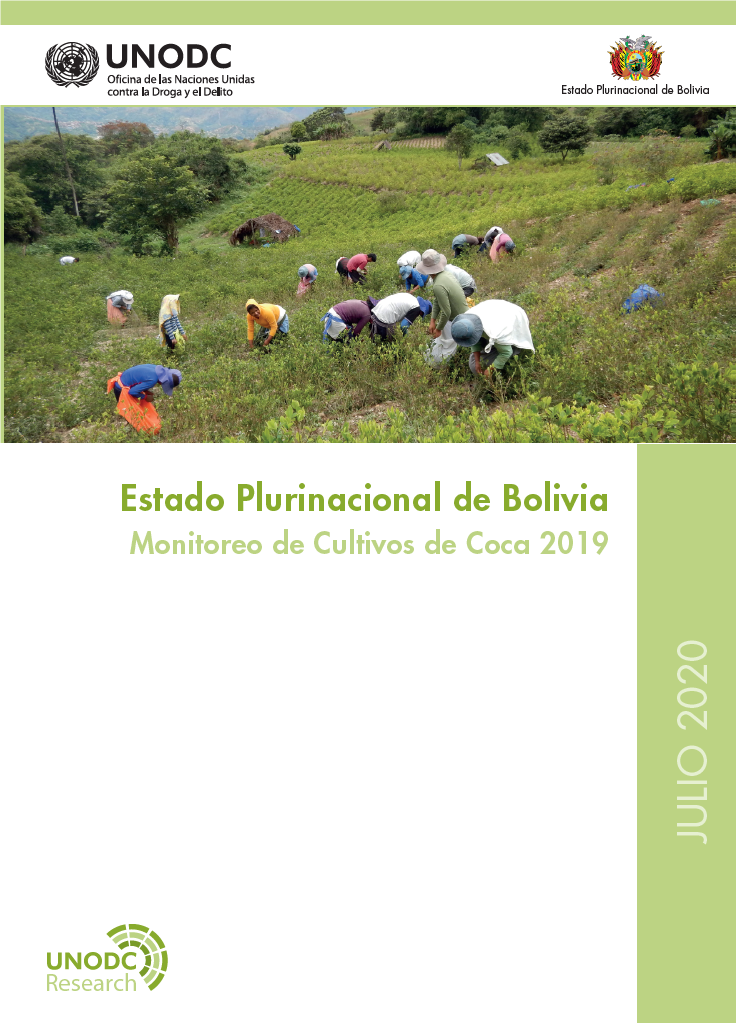With funding from the European Union:
The 2019 UNODC monitoring report shows an increase in coca cultivation in Bolivia
 La Paz/Vienna, 29 July 2020 – In 2019, coca cultivation in Bolivia has increased by 10 per cent compared to 2018, according to the latest Coca Cultivation Monitoring Report, developed with funding from the European Union, presented today in La Paz by the United Nations Office on Drugs and Crime (UNODC) and the government of the Plurinational State of Bolivia. The area under cultivation has effectively increased by 2,400 hectares (ha) from 23,100 ha in 2018 to 25,500 ha in 2019.
La Paz/Vienna, 29 July 2020 – In 2019, coca cultivation in Bolivia has increased by 10 per cent compared to 2018, according to the latest Coca Cultivation Monitoring Report, developed with funding from the European Union, presented today in La Paz by the United Nations Office on Drugs and Crime (UNODC) and the government of the Plurinational State of Bolivia. The area under cultivation has effectively increased by 2,400 hectares (ha) from 23,100 ha in 2018 to 25,500 ha in 2019.
According to the Report, the regions of the Yungas of La Paz, the Tropics of Cochabamba (which includes producing areas in Santa Cruz and Beni) and the North of La Paz represented 64, 34 and two per cent of the coca growing areas in the country, respectively.
Combining the use of satellite images complemented with information collected through field work, UNODC detected an increase in the area under coca cultivation in all the three producing regions: in the Yungas region of La Paz an increase of 9 per cent reaching 16,296 ha has been detected; in the Cochabamba Tropics, an increase of 13 per cent was registered, reaching 8,769 ha; whereas, in the region of the North of La Paz, the cultivated areas increased by 44 per cent reaching 468 ha of coca crops.
The highest increase of coca cultivation in the Yungas of La Paz was detected in the province of Sud Yungas, with an increase of 597 ha, reaching 10,374 ha of coca cultivation in 2019. In the Tropics of Cochabamba, the province of Carrasco registered an increase of 720 ha of coca cultivation, reaching a total of 3,842 ha of coca cultivation in 2019.
The Bolivian Government reported a decrease in the rationed/eradicated area between 2018 and 2019, from 11,174 to 9,205 ha. In 2019, 79 per cent of the rationed/eradicated area is located in the Tropics of Cochabamba, 16 per cent in Yungas and the North of La Paz, and 5 per cent in the departments of Santa Cruz and Beni.
Starting in 2019, UNODC is validating the rationed/eradication data on coca cultivation in Bolivia provided by the government. Out of a total of 8,121 ha of rationed/eradicated coca cultivation reported to UNODC by the Bolivian Government, a sample of 1,598 ha was validated, of which 88 per cent was performed through the identification on satellite images, eight percent through field missions (after governmental field intervention) and four per cent through concurrent field inspections.
The Report also indicated the presence of coca cultivation in six of the 22 protected areas at the national level. In these areas, a total of 315 ha of coca cultivation were identified located within the three producing regions. The national park most affected due to coca cultivation was Madidi, followed by Amboró, Apolobamba and Cotapata; the only national park to register a reduction was Carrasco. Also, 1,843 ha of coca cultivation have been identified in areas meant to be destined to agricultural activities within the National Parks of Isiboro Secure and Carrasco.
These figures reflect the main findings of the latest Coca Cultivation Monitoring Report in Bolivia, carried out within the framework of the UNODC Support Programme, funded by the European Union, for the Implementation of the Action Plan of the Strategy to Fight Drug Trafficking and Reduce Surplus Coca Crops of the Plurinational State of Bolivia.
According to Government data, the volume of coca leaf traded in the two authorized markets (Villa Fatima in the Department of La Paz and Sacaba in the Department of Cochabamba) was 23,877 metric tons in 2019. Ninety per cent of the legally traded coca leaf comes from the Villa Fatima market, whereas the remaining 10 per cent comes from the Sacaba market. In 2019, the weighted average price of coca leaf in these authorized markets was US$12.5 per kg.
Thierry Rostan, UNODC Representative for Bolivia, also highlighted some recommendations to improve the control of coca crops, including
1) The need to increase the control measures to avoid the expansion of coca cultivation to non-authorized areas such as those surrounding the limits of the province of Ayopaya in the department of Cochabamba and the provinces of Sud Yungas and Inquisivi in the department of La Paz, and
2) Continuing to strengthen the processes of rationing/eradication, community control of licit cultivation and impact mitigation, promoting the integral development in the coca producing areas, to thus avoid the expansion of surplus production of coca crops.
Access the full Coca Cultivation Monitoring Report here (in Spanish)
For further information, please contact in La Paz:
Thierry Rostan, UNODC Representative in Bolivia
Tel: (+591-2) 2624-365